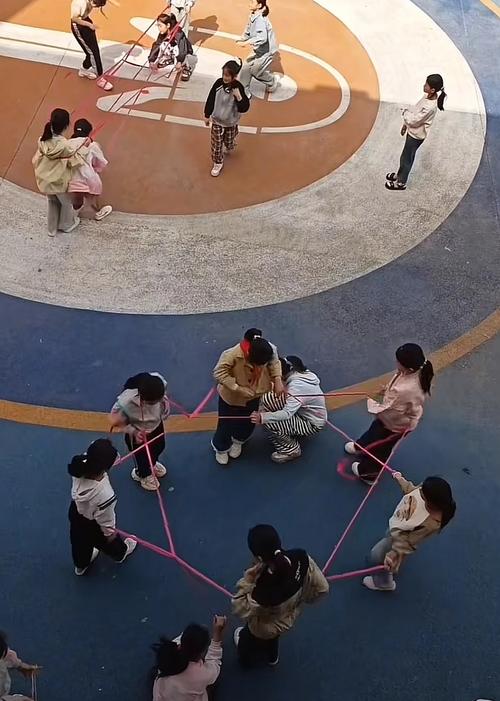
by sportswriter He Leijing
NANJING, June 1 (Xinhua) — Laughter rings out across a sunlit playground in rural eastern China, as children at a primary school form colorful knots of motion, using their bodies to anchor vibrant strings that weave in and out of intricate shapes – stars, pentagons and abstract forms.

The game, known as Cat’s Cradle, evokes memories of childhood for generations of Chinese adults who recall hours spent deftly looping string between their fingers.
But at the Tangjian Central Primary School in Suqian, Jiangsu Province, schoolchildren have reinvented it as a modern, physically engaging team activity that blends creativity with agility, coordination and laughter.
The upgraded version is winning hearts far beyond the schoolyard. Video clips of the students performing their innovative routines have gone viral on social media, amassing tens of millions of views and comments celebrating their ingenuity and nostalgic charm.
OLD GAMES, NEW TWISTS
At this primary school, jumping rope is one of the students’ most beloved hobbies. Each day, clusters of children gather during breaks to leap, twist and flip – some even adding gymnastic flourishes such as somersaults and handstands, bringing a fresh dynamism to an age-old activity.

“Skipping ropes are inexpensive, yet infinitely adaptable. It has become our school’s signature sport,” said school principal Geng Jinbao, adding that every class boasts a performance jump rope team, and the school has clinched five national titles in competitive skipping events.
Once burdened by rigorous academic demands that left little room for physical activity, Chinese teenagers are now reaping the benefits of sweeping educational reforms, with initiatives aiming to ease academic pressure and promote holistic development, including more time for fitness and fun.

“Chinese schools are now encouraged to design creative sports activities that engage students’ interests and make sports a joyful part of their growth,” said Geng.
Across China, innovation is reshaping the way children move. In southwest China’s Guizhou Province, middle-schoolers follow upbeat pop music during daily fitness sessions. In Jiangsu’s Nantong, over 2,000 students sprint in synchronized patterns that echo the nostalgic mobile game Snake.
Some schools are even reimagining traditional Chinese culture as athletic spectacle, transforming martial arts, lion dancing and the folk game diabolo into sweat-inducing, skill-building activities that marry fitness with cultural heritage.

Amid these homages to the past, the future sporting landscapes are also taking root. Increasingly, Chinese schools are embracing AI to personalize student workouts and fine-tune physical education.
Many schools in Beijing have introduced AI-powered sports facilities equipped with high-speed cameras and sensor technology, as the city’s government has implemented a work plan for AI application in the education sector, deepening the use of AI in sports to offer scientific and targeted guidance for students’ fitness and exercise.
AI playground systems, for instance, capture data on sprints, long jumps and jumping rope, correcting students’ technique and tailoring training plans. Coupled with wristbands that monitor heart rate and other indicators, these innovations are also alert to potential safety risks.

During recess at a primary school in Suzhou, 10-year-old Xu Zihao battles friends in a football juggling contest, while an AI-enabled screen displays their juggling counts, speeds and accuracy, updating a leaderboard in real time.
“This kind of training is just so much fun,” said Xu. “We can compete whenever we have free time, and it keeps a record of how we’re improving every day.”
NO SPORTS, NO EDUCATION
China’s diverse landscape of campus athletics is widely seen as a crucial step towards nurturing a healthy and happy generation. Data released in 2024 show that 19 percent of Chinese children aged 6 to 17 are overweight or obese, while a 2023 study found that 52.7 percent are affected by myopia.
The country’s 14th Five-Year Plan and long-range objectives through 2035 call for improving preschool nutrition, curbing childhood obesity and myopia, and ensuring time for school physical education and extracurricular exercise. Official guidelines now require students to engage in at least two hours of physical activity daily.
Beijing has launched initiatives to make PE classes more engaging by encouraging students to “work up a sweat,” integrating class-level sports leagues, and making at least one of the “big three ball games” – basketball, football or volleyball – a mandatory part of the PE curriculum.
Meanwhile, in Shanghai, the two-hour daily exercise window has been transformed into a highly anticipated time of vitality for schoolchildren, boosted by smart technology and the excitement of friendly competition.
Experts note that the benefits extend far beyond physical strength. Former NBA star and youth sports advocate Yao Ming said that sports should also be viewed as a way to build children’s emotional resilience and character.

“We must encourage more children to step onto sports fields, reconnect with nature, and engage in real human interaction,” said Yao. “Only then can they grow into a generation with not just strong bodies, but strong minds.”
Safety concerns are also gaining prominence. “Beyond physical risks, doing sports with new technologies, for instance, demands robust data management systems to safeguard students’ information and prevent misuse or leakage,” said Wang Zongping, a professor at Nanjing University of Science and Technology.
Wang added that schools are increasingly abandoning rigid and repetitive training regimes in favor of collaborative and inspirational activities that foster teamwork and even awaken dreams.

Chen Haoyu, a sixth grader at Tangjian Central Primary School, was once so shy that he hardly dared answer questions in class, but gradually built his confidence through jumping rope. “It opened a switch in my heart,” said Chen, who has competed overseas and claimed two gold medals in international games.
“Sports have also taught me to face challenges bravely,” said the 12-year-old. “That’s a lesson I’ll carry for the rest of my life.” ■

